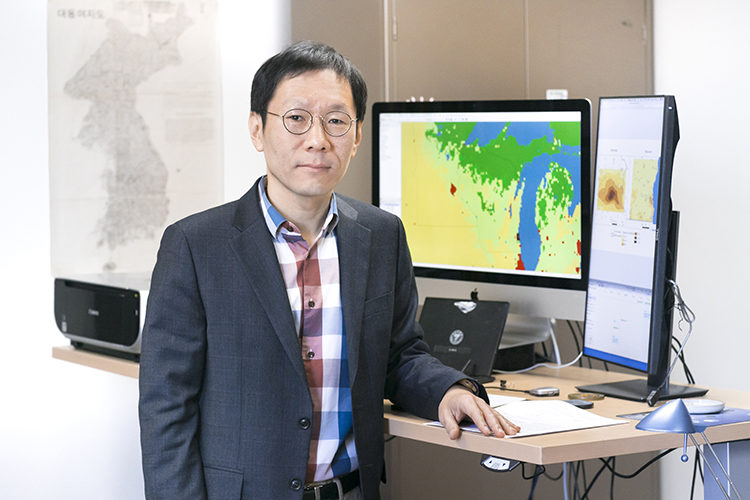Things are heating up in Milwaukee.
As climate change drives global temperatures higher, heat can cause health problems for multitudes of people, especially in urban environments.
Woonsup Choi wondered if it might affect certain people in particular.
“I wanted to see whether this heat stress map would be somehow associated with the distribution with the socio-economic categories in Milwaukee,” he said. “In some parts of the city, the temperature may go up a little more than in other parts, depending on how dense the (population or buildings) are, how much vegetation is out there, or if there are parks nearby.”
Choi is an associate professor of geography at UWM. His main research focuses on how climate change influences water storage and flow, but his recent side project sought to determine if lower-income areas of urban environments are more susceptible to heat stress due to hotter nighttime temperatures than more affluent neighborhoods.
“Maybe (rising temperatures) may not be a big deal to those who live in a nice house that is well air-conditioned,” he reasoned. “But if people live in a building that is not well-ventilated or air-conditioned, then heat stress could be very dangerous.”
The mercury’s rising
Choi focused on Milwaukee and Minneapolis as midsize Midwestern cities. He collected temperature data from each area from a repository of climate model outputs dating back to 1950 and forth over the next 80 years. He focused on extreme events – those nights where temperatures fell into the top 5% of the hottest temperatures recorded that year.
This type of data is “coarse,” as Choi describes it. The climate modeling breaks the surface of the earth into large, grid-like pixels, with each pixel covering several counties in Wisconsin. To obtain refined data for the cities, Choi borrowed a technological fix from researchers at the University of Idaho, who were able to reduce the size of the pixels down to mere kilometers.
Then he began to look at how frequently each area experienced extreme temperatures – historically, and what the model predicted for the future. Scientists need to think about the data statistically, he added. The model can’t predict which nights in the future will see extreme heat, but it can calculate how many nights might experience hot temperatures within a 10-year period.
“The number of days that have a hot night is going to increase a lot in a 10 year period. Right now, it is close to zero – just a few days, when aggregated in 10 years,” Choi said. “But in the future period, there will be, say, five or six days per decade. It’s likely to occur a lot more frequently.”
The city heat sink
Not only will there be more hot nights, but some areas of the city will get warmer than others. Choi’s data shows that the city center will tend to experience higher temperatures than the outskirts or the suburbs, especially in Minneapolis.
In fact, cities in general usually experience hotter nighttime temperatures than rural areas. “Urban heat islands” are a product of the concrete and pavement used to build them, as well as significant artificial heat from human activities.
“During daytime, the sun is sending energy to the ground. The ground will reflect some of the incoming energy, and also absorb some of the incoming energy,” Choi said. “Different materials have different fractions between absorption and reflection. Urban and rural areas have quite different material – whether pavement, vegetation or bare ground. With pavement, a lot of energy is absorbed by the ground.”
At night, that heat energy slowly seeps back out. Because pavement and asphalt absorb more heat than dirt, cities release more heat at nighttime than rural areas, contributing to greater nighttime temperatures.
A socioeconomic factor?
Though residents of poorer neighborhoods are often at greater risk for health hazards than more affluent areas, Choi found that’s not the case when it comes to heat stress.
“I could not find a strong link to socioeconomics as much as I expected,” Choi said. The data shows that residents of Milwaukee and Minneapolis currently experience roughly the same nighttime temperatures, no matter their location or income status. Choi warns that there might well be a disparity in the future, however.
And there are limitations to his findings. Historical temperature data doesn’t include humidity levels, and increased humidity can exacerbate heat stress among urban residents.
But there might be ways to combat those coming hot nights – a “hot” topic, especially as Milwaukee readies to host the 2020 Democratic National Convention and Democratic candidates make climate change a central part of their platform.
Choi said the simplest solution is to make the city greener – literally.
“One way to reduce the impact could be planting more trees in neighborhoods that do not have large parks,” he said. “Trees and vegetation generally absorb water from the soil and release it into the atmosphere. It’s called transpiration and (like evaporation), it has a cooling effect. That’s the low-hanging fruit, I believe.”
Until then, we’re all in the hot seat together.






